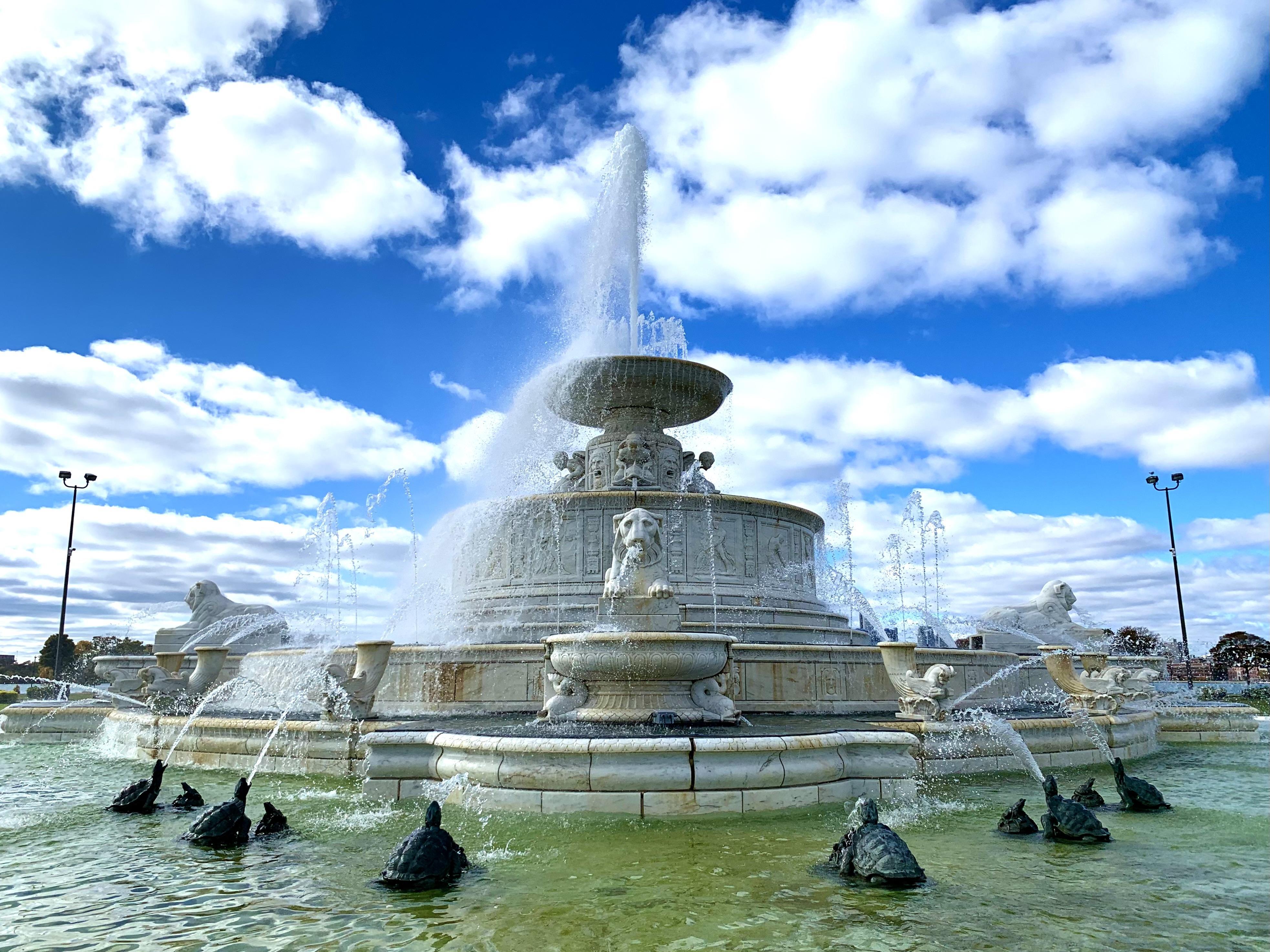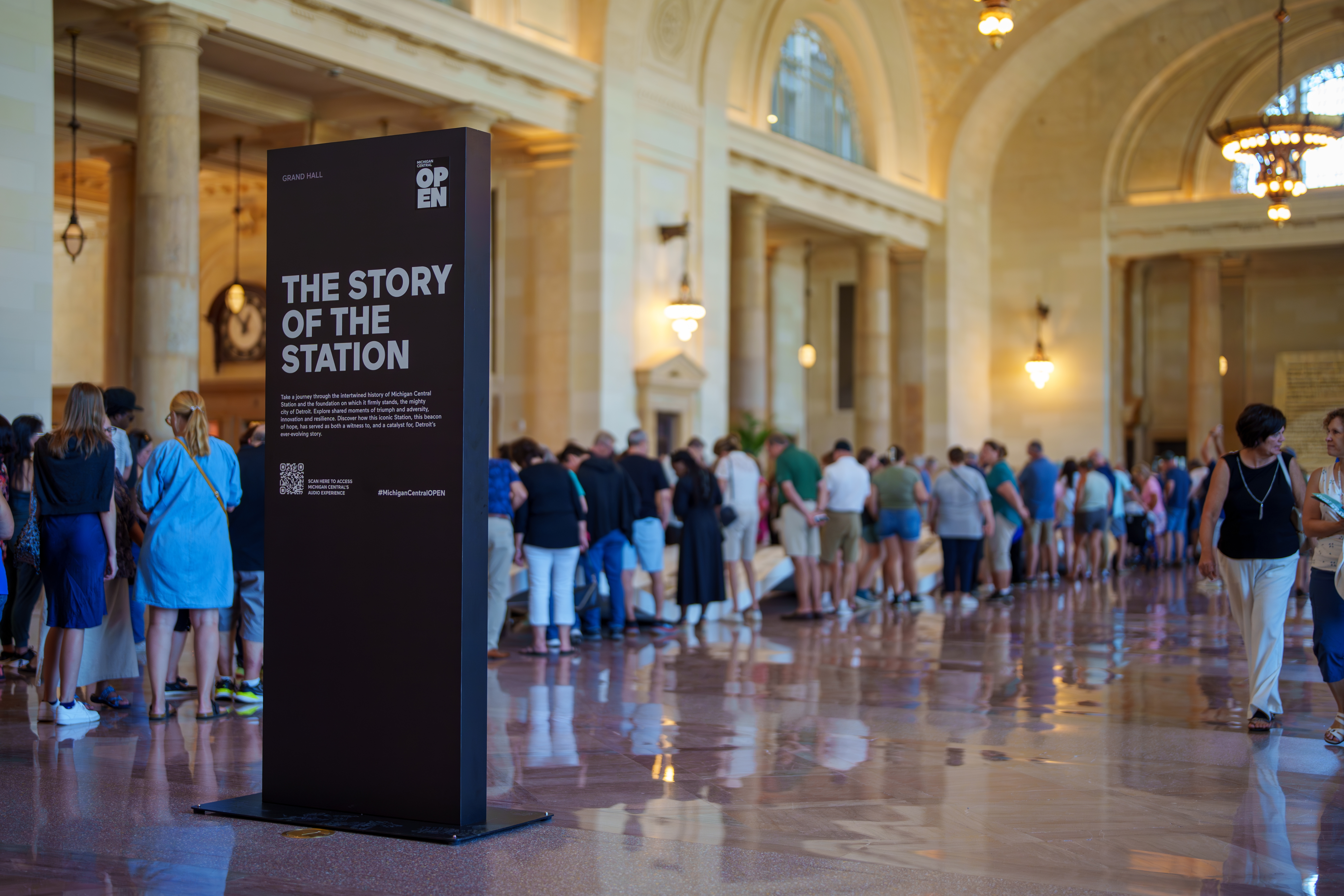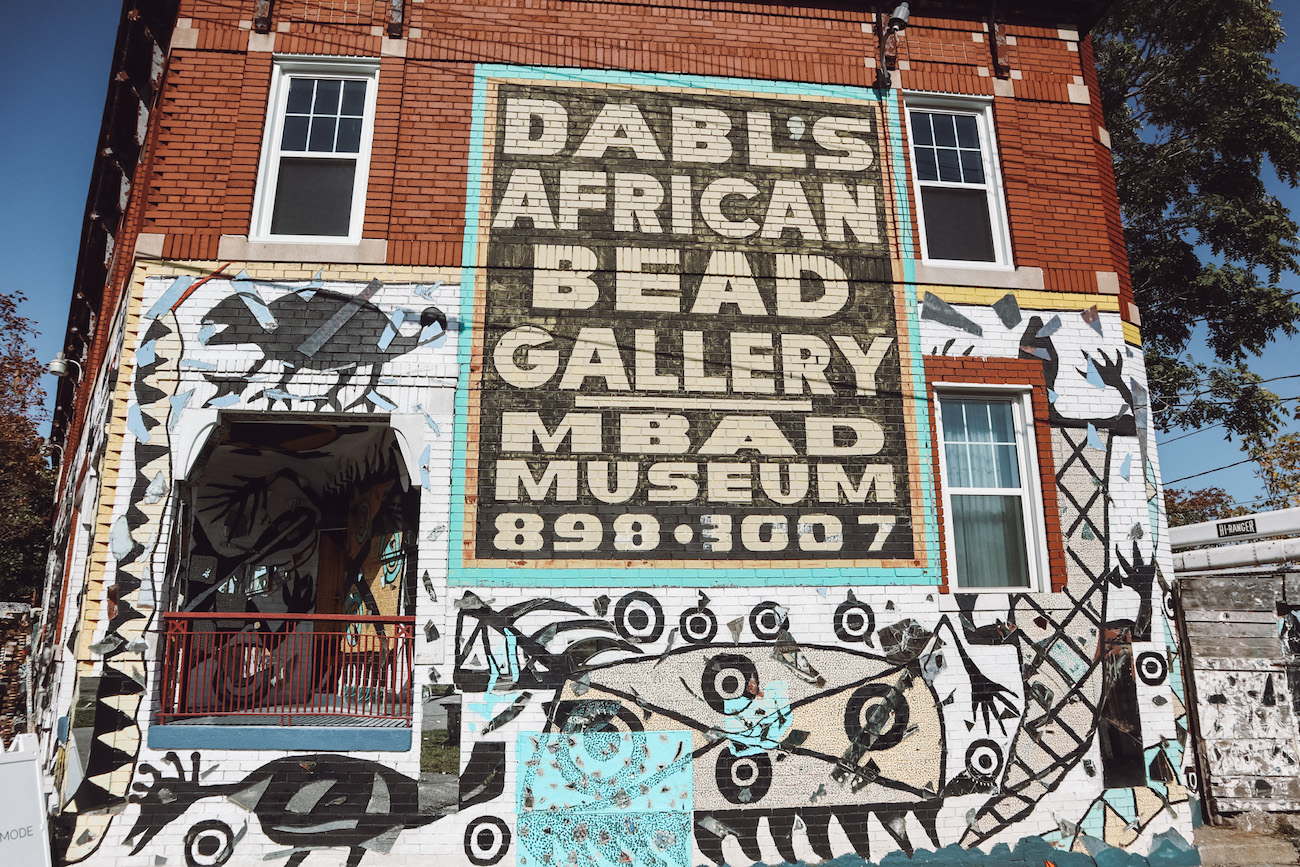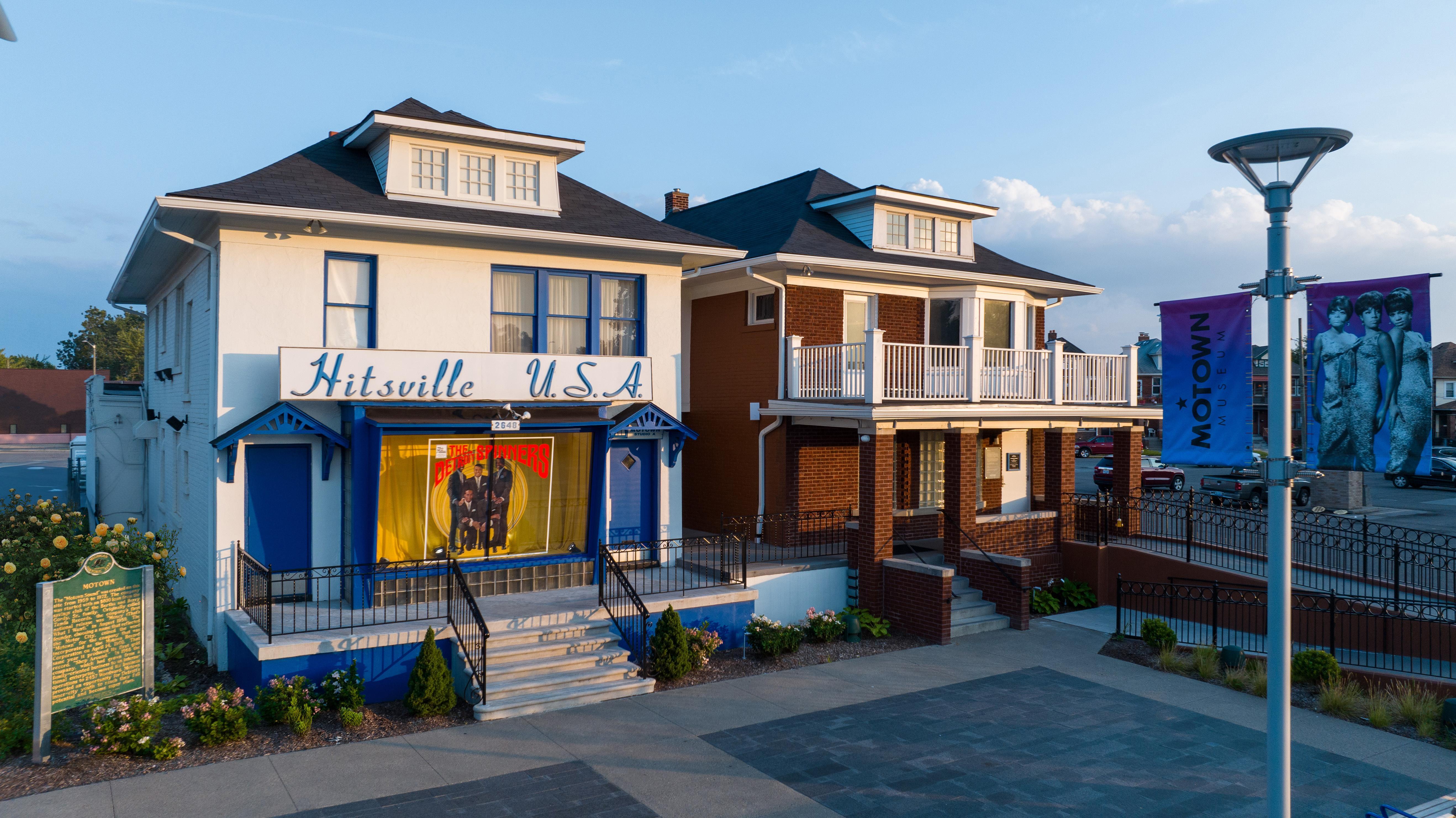Architectural Landmarks of Detroit
Detroit contains an abundance of architectural sights, from gilded-age towers and theaters to modern skyscrapers. To choose just a few is near impossible, but for your consideration, here are the top four:
The Renaissance Center
The most distinctive part of Detroit’s skyline is the brutalist architectural maze that is the Renaissance Center. Its seven interconnected towers, the tallest of which is the 73-story home to the Marriott hotel, sit on the downtown riverfront. A group of the area’s top businessmen conceived this building, seeing it as an urban renewal project to spur development. The first tower opened in 1976. Nearly 50 years later, its future is in the air as owner General Motors moves its headquarters elsewhere. See the RenCen in its full glory while you can!
Scott Fountain
James Scott was not a popular man. When he passed in 1910, many residents wanted to reject the money he left for a monument in his memory. The statue of the man known for his petty feuds and unsavory character traits did come to pass, but it sits overshadowed by the fountain bearing his name. Located on the west end of Belle Isle, the marble fountain spans 500 feet across, making it visible from the mainland. It prominently features lions, dolphins, turtles, frogs, and cherubs.

McGregor Memorial Conference Center
Nestled in Wayne State University’s midtown campus, this award-winning building and reflecting pool were designed by Minoru Yamasaki. Yamasaki, originally from Seattle, moved to Detroit in 1945. He joined the architecture firm Smith, Hinchman & Grylls before breaking out on his own in 1949. In McGregor, he sought to create a gateway between the university and the city. He later designed three additional buildings on Wayne State’s campus plus structures around the globe, including New York’s World Trade Center. The McGregor Memorial Conference Center serves as a meeting and event space, and anyone can enjoy the ponds and garden for a moment of quiet stillness in the noisy city.
Michigan Central Station
Few buildings have captured hearts and minds like Michigan Central Station. The train station serviced Detroiters and visitors from 1913 into the 1980s, when it was left to the elements. Even in its most derelict state, the train station was a beauty to behold. In 2024, the Ford Motor Company reopened the restored lower level to the public and continues to transform the building into a hub for mobility innovation.

Artistic Landmarks of Detroit
Not only does Detroit boast the top art museum in the country, it is home to countless galleries, artist collectives, and public art displays. Here are some of the most unique:
The Heidelberg Project
In 1986, Tyree Guyton, along with family members and area children, began painting bright polka dots on Heidelberg Street’s abandoned houses. Guyton’s neighborhood had suffered a dramatic downturn in the decades following 1967’s unrest, and his response was to turn it into art. He built installations with discarded items like stuffed animals, televisions, car parts, and bicycles. The found art masterpieces met with controversy and officials ordered several houses demolished. However, the Heidelberg Project has become a treasured part of the city, attracting international visitors while the surrounding neighborhood transformed into a safer community.
Hamtramck Disneyland
Dmytro Szylak immigrated to the United States from Ukraine in the 1950s. He took up art after retiring from the auto industry and the result is another popular attraction in the city. For 30 years, Szylak built towering structures between and above two garages in his yard, creating a whimsical folk art assemblage of windmills, carousels, and jet planes. While this installation has also faced controversy, Hamtramck leaders soon supported it. Szylak passed away in 2015, but his creation lives on thanks to a local art collective’s support. To see Hamtramck Disneyland, venture into the alley bounded by Klinger and Sobieski Streets, north of Commor. The Heidelberg Project and Hamtramck Disneyland are embedded in active neighborhoods, so visitors should remember to respect residents and private property.
Dabls Mbad African Bead Museum
Head down Grand River Avenue near West Grand Boulevard and you can’t miss the dazzling exterior facade of the Dabls Mbad African Bead Museum. Founded by Olayami Dabls, it is part art installation, part bead store, and part museum. The beads come from different African cultures and represent more than beautiful accessories. Dabls teaches the complex meanings behind them as well as their cultural significance. One of the buildings was recently demolished, but outdoor exhibits and the museum are still alive and well. Visitors can enjoy bead and jewelry workshops and tours by appointment.

The Spirit of Detroit
This sculpture of a human figure sits outside the Coleman A. Young Municipal Center, holding a sun-like sphere in one hand and a family in the other. Marshall Fredericks created the iconic bronze piece in 1958. It has since become part of Detroit’s official logo and even the distinctive light green color appears in Detroit’s branding. The statue displays extra spirit when it’s playoff time, wearing giant jerseys to support Detroit’s sports teams.
Monument to Joe Louis
Joe Louis moved to Detroit as a youngster before becoming the world heavyweight boxing champion for an unprecedented 11 years. In 1938, Louis faced a Nazi-backed opponent, handily defeating him in the first round. The victory forever endeared Louis to his hometown and made him a national hero - a significant feat for a Black man in a racially divided country. Outside the ring, Louis served in the army during WWII, received the Legion of Merit in 1945, and supported war relief efforts on the home front. In his post-boxing career, he honed his golfing skills at Palmer Park before integrating the Professional Golf Association. The 24-foot “Joe Louis fist” hangs on Jefferson Avenue across from Hart Plaza. See it up close for full impact.
Historical Landmarks in Detroit
Nearly every landmark on this list could be considered historic, but these brim with history; they represent some of the area’s key chapters:
Hart Plaza
The Detroit River at Woodward Avenue is the approximate spot Antoine de le Mothe Cadillac established Fort Pontchartrain du Détroit in 1701. The current Hart Plaza opened in 1975 and hosts some of the city’s most popular events including the Detroit Electronic Music Festival and Motor City Pride. Here, visitors will find a microcosm of Detroit's history, including:
- The Martin Luther King, Jr. statue commemorates the Detroit March to Freedom in June 1963, where King gave his “I Have a Dream” speech for the first time.
- The Gateway to Freedom International Memorial to the Underground Railroad depicts a group of people, including a baby and a young child, who have escaped from slavery, looking across the river to Canada. Detroiters helped 45,000 people reach freedom using Underground Railroad stops across the city. A companion memorial is located in Windsor.
- Transcending, commissioned by the Michigan Labor History Society, honors Michigan’s role in the labor movement. Detroit’s most well-known union, the UAW, formed in 1935. However, labor unions have advocated for the rights of Detroit’s workforce for 200 years. Transcending consists of two steel arcs, 63 feet high, and several boulders near its base with reliefs illustrating the struggle and triumphs of workers.
Historic Fort Wayne
Fort Wayne’s original purpose was to defend against a British invasion from Canada. Shortly after it was built in 1840, a treaty rendered it unnecessary. The Fort became an infantry garrison for troops from the Civil War through the Vietnam War. Eventually, the City of Detroit’s recreation department took over management with assistance from the Historic Fort Wayne Coalition. From May through October, visitors can see the fort and its buildings, and even venture inside some of them. A Native American burial mound is also located on the grounds, thought to be around 1000 years old.
Algiers Motel Historic Marker
Detroit has grappled with the civil unrest of 1967 for decades. Long-simmering social and political tensions finally gave way when police raided a blind pig in a Black neighborhood that July. Looting, fires, and the National Guard followed. Over five days, dozens of people were injured and 43 people lost their lives, including three Black teens at the Algiers Motel. Fifty-six years later, a historical marker has been dedicated to that tragedy. The Motel was demolished in 1979. The marker and a beautiful park now exist in its space on Woodward, south of Euclid.
Hitsville, USA
Motown introduced America to Stevie Wonder, Diana Ross and The Supremes, The Four Tops, Marvin Gaye, and many more talented artists. The Motown sound continues to influence musical acts across genres. It all started in the blue and white house on West Grand Boulevard. Founder Berry Gordy, Jr. converted the home into a recording studio and record label headquarters in 1959. The growing business later expanded to other nearby houses and today is a world-class museum.

Detroit Landmarks of Industry and Innovation
Detroit has been home to many industries beyond cars, but few landmarks still exist (RIP, giant stove). He are the most iconic that remain:
Piquette Plant
The Piquette Plant is the location of the 1908 birth of the Ford Motor Company’s Model T. Demand for the vehicle was so high that the company soon had to move to a larger location. Innovations by Henry Ford and his employees - including early experimentation with an assembly line - resulted in fast production and a record-breaking 100 cars produced in one day. Faster meant cheaper and the Model T became the first car affordable for the middle class, forever changing how we move.
Uniroyal Tire
A giant tire greets visitors to the Metro Detroit region via I-94. Standing 80 feet tall, the steel and fiberglass structure was originally a 100-passenger Ferris Wheel for the 1964 New York World’s Fair. When the fair ended, Uniroyal offered to donate it to New York City, which wasn’t interested. Instead, it ended up in Allen Park, without the rotating gondolas. And while Uniroyal isn’t a Detroit company, it had a presence on the riverfront section now called the Uniroyal Promenade.
Pewabic Pottery
A Detroit institution was born when Mary Chase Perry Stratton, an artist working with clay, discovered her neighbor, Horace Caulkins produced kilns. Stratton named the business Pewabic after a copper mine near her hometown of Hancock, Michigan, which was taken from an Ojibwa word for metal. While Caulkin innovated kiln technology, Stratton worked for years to develop her own glazes. She perfected the distinctive iridescent colors for which Pewabic is known. Pewabic tiles can be found in schools, churches, libraries, and homes across the country. The studio is a distinctive Tudor Revival with a towering smoke stack featuring the famous tiles. Today, the Pewabic Society carries on the legacy of its founders by offering classes and tours, while continuing to produce wares.
Ambassador Bridge/Gordie Howe Bridge
The nearly 100-year-old Ambassador Bridge is the busiest crossing point between the US and its southern neighbor, Windsor, Ontario. The bridge opened in 1929 and held the title of the world’s longest suspension bridge for about two years. A single bridge was deemed insufficient, so 2025 will see the opening of the Gordie Howe International Bridge to the west. Detroit’s newest landmark is visually distinct from its companion as it is cable-stayed where the Ambassador is suspended. Time will tell how influential the bridge will be, but it is now part of the visual landscape of Detroit.
YOU MAY ALSO LIKE
For more than 110 years, Michigan Central Station has stood tall just about two miles…
Pairing a cup of coffee with eye-catching architectural design is a unique tone setter for…
Are you ready to #VisitDetroit for the gram? You'll want to hit these most Instagrammable…






